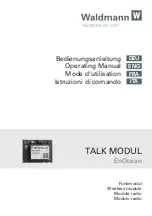
7-25
z
When the priority of a port is changed, MSTP will re-calculate the role of the port and initiate a state
transition.
z
Generally, a lower priority value indicates a higher priority. If you configure the same priority value
for all the ports on a bridge, the priority of a port depends on the index number of the port. Changing
the priority of a port triggers a new spanning tree calculation process.
Configuring the Link Type of Ports
A point-to-point link is a link directly connecting two bridges. If the two ports connected by a
point-to-point link are root ports or designated ports, the ports can rapidly transition to the forwarding
state after a proposal-agreement handshake process.
Make this configuration on the root bridge and on the leaf nodes separately.
Follow these steps to configure the link type of a port or a group of ports:
To do...
Use the command...
Remarks
Enter system view
system-view
—
Enter Ethernet interface
view or WLAN Mesh
interface view
interface interface-type
interface-number
Enter interface
view or port
group view
Enter port group view
port-group manual
port-group-name
Required
Use either command.
Configure the link type of ports
stp point-to-point
{
auto
|
force-false
|
force-true
}
Optional
The default setting is
auto
;
namely the port automatically
detects whether its link is
point-to-point.
z
If a port works in auto-negotiation mode and the negotiation result is full duplex, this port can be
configured as connecting to a point-to-point link.
z
If a port is configured as connecting to a point-to-point link, the setting takes effect for the port in all
MSTIs. If the physical link to which the port connects is not a point-to-point link and you force it to
be a point-to-point link by configuration, the configuration may incur a temporary loop.
Configuring the Mode a Port Uses to Recognize/Send MSTP Packets
A port can receive/send MSTP packets of two formats:
z
dot1s
:
802.1s-compliant standard format, and
z
legacy
:
Compatible format















































